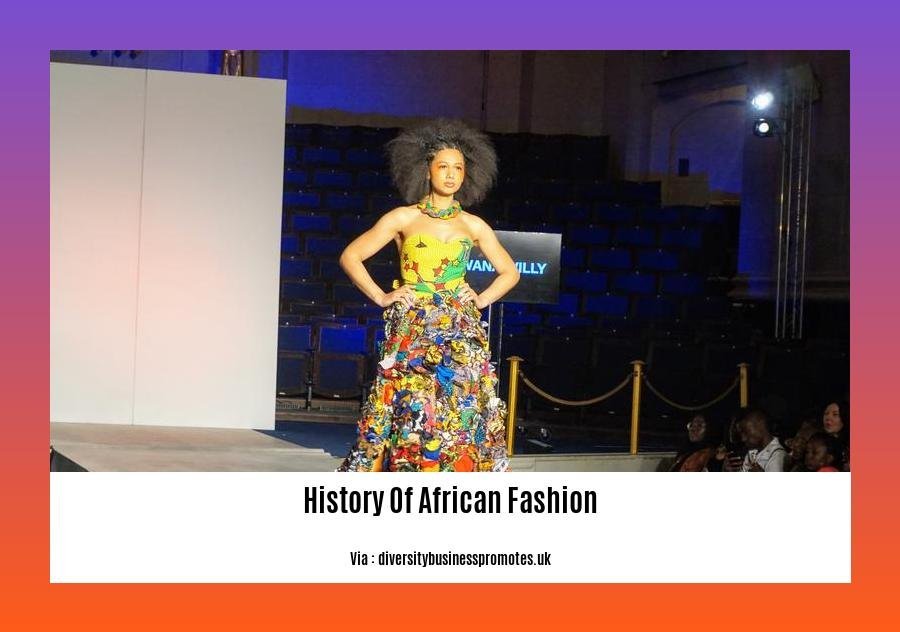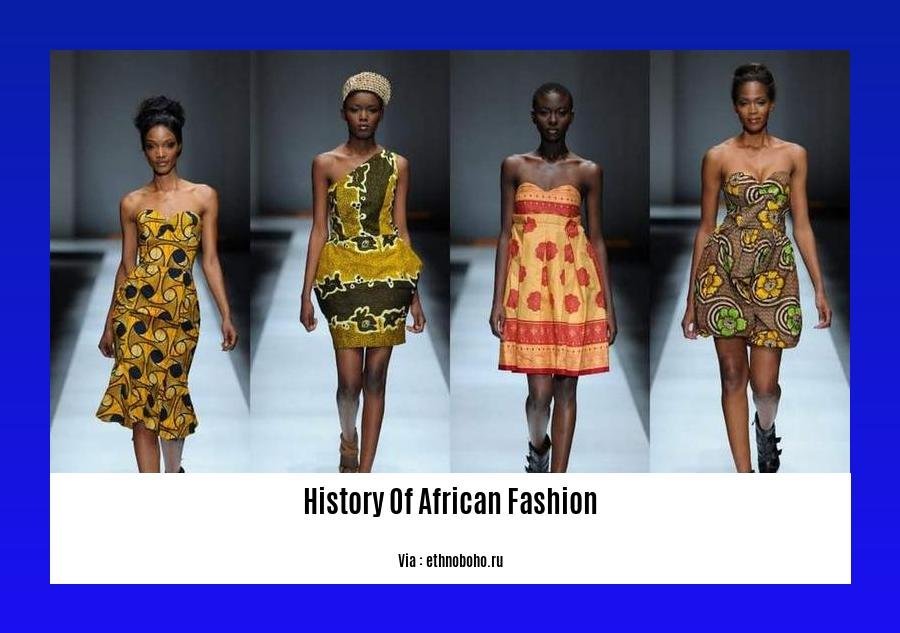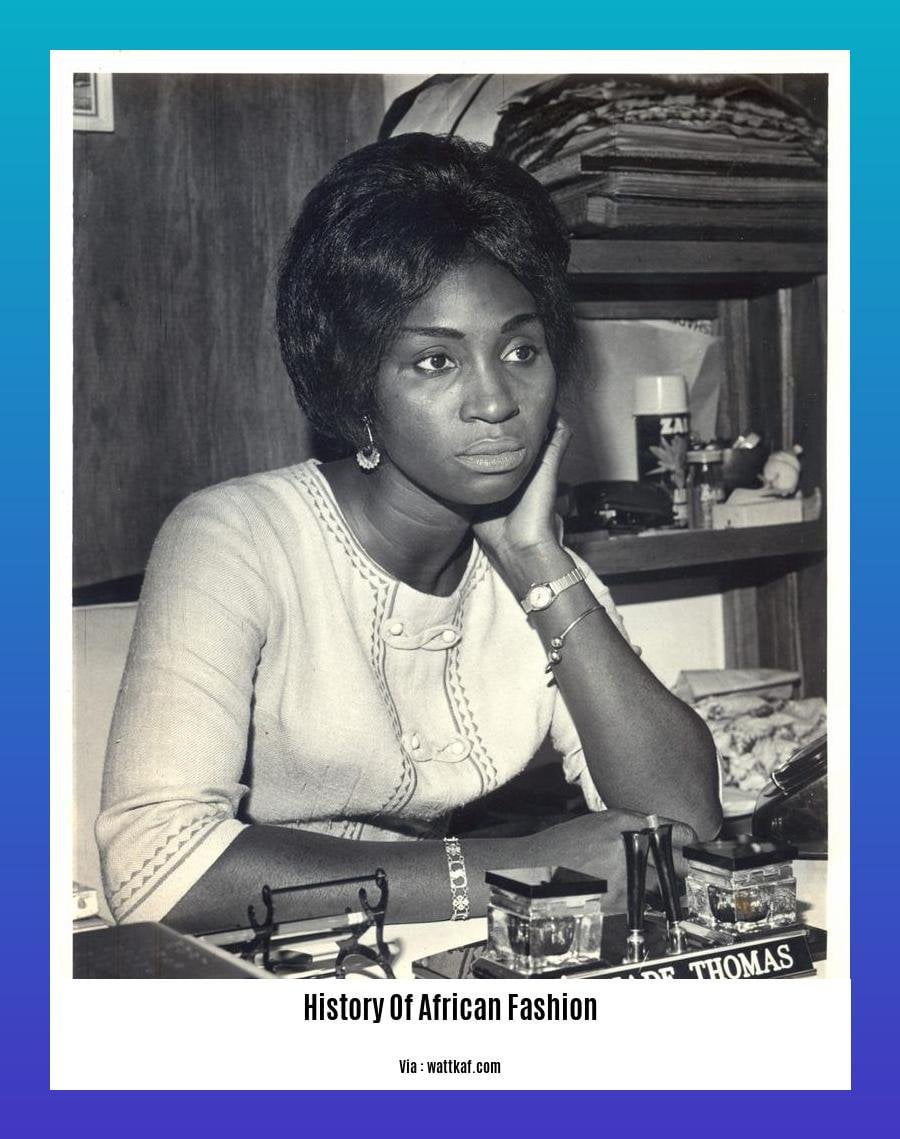Embark on a captivating journey through time as we unravel the rich history of African fashion in “[A Journey Through Time: Exploring the Rich History of African Fashion]”. Discover the vibrant tapestry of styles, cultural influences, and the profound impact fashion has had on African identity and society. From ancient civilizations to contemporary trends, we’ll delve into the stories behind each unique garment, celebrating the diverse expressions of creativity and resilience that have shaped the fashion landscape of the African continent.
Key Takeaways:
The history of African fashion is diverse and has influences from trade, colonialism, and the continent’s cultures.
Pre-colonization, Africans wore light clothing made from locally-sourced materials such as bark cloth and furs.
Colonization brought changes to African fashion with the introduction of European clothing and discouragement of traditional attire in many workplaces.
History of African Fashion

The history of African fashion is a vibrant and complex tapestry, spanning centuries and encompassing diverse cultures and influences. From the earliest days of humanity, Africans have adorned themselves with clothing and accessories that reflect their unique identities, cultural heritage, and social status.
Pre-Colonial Africa:
Prior to the arrival of European colonizers, African fashion was largely influenced by the continent’s diverse climates, available materials, and cultural traditions. Natural fibers such as cotton, wool, silk, and bark cloth were widely used to create garments that were both functional and aesthetically pleasing.
Colonial Influence:
The arrival of European colonizers in the 15th century marked a significant turning point in the history of African fashion. Colonizers brought with them their own clothing styles and imposed them on the African population. Traditional African attire was often discouraged or even banned in colonial workplaces and institutions.
Post-Colonial Revival:
After gaining independence from colonial rule, many African countries experienced a resurgence of interest in their traditional clothing. Designers and fashion enthusiasts began to explore ways to fuse traditional elements with modern styles, creating a new era of African fashion that celebrated the continent’s rich cultural heritage.
Contemporary African Fashion:
Today, African fashion is a thriving and dynamic industry, with designers from all over the continent showcasing their collections on international runways and in fashion magazines. African fashion designers are drawing inspiration from their cultural roots, as well as from global trends, to create unique and innovative designs that are both stylish and meaningful.
African fashion has come a long way since the days of colonization, and it continues to evolve and captivate the world with its vibrant colors, bold patterns, and rich cultural symbolism.
To understand the cultural significance and evolution of traditional attire, read the in-depth article on the History of African Clothing. Learn about the diverse influences that have shaped the rich textile traditions of the region.
Discover the fascinating history of Agusan del Sur, a province in the Philippines, by delving into its past through the History of Agusan del Sur. Explore the intriguing events and influences that have shaped this region’s unique identity.
Take a journey through the skies and explore the History of Airlines in India, from their humble beginnings to their current status as a vital part of the nation’s infrastructure. Learn about the key players, milestones, and challenges that have shaped the development of India’s aviation industry.
Clothing styles varied greatly between regions, reflecting different cultures and climates.

Imagine a world where each region had its signature clothing style, influenced by its unique culture and climate. That was the reality of fashion in the past.
Cultures and Fashion:
In the vast tapestry of human history, clothing styles have been as diverse as the cultures that created them. From the flowing robes of ancient Egypt to the intricate beadwork of Native American tribes, each garment told a story of its people’s identity and heritage.
Native Americans used buffalo plaid, originally worn by Scottish traders, in exchange for buffalo. Symbolic of courage and strength, it became a staple in their wardrobes.
The Maasai and Yoruba of Africa shared a rich beadwork tradition that adorned their clothing, carrying cultural significance and personal expression.
In North America, beading dates back to 11,000 B.C, showcasing the creativity and artistry of nomadic tribes.
Turbans, worn by the Tuareg people of North Africa and a style icon like Elizabeth Taylor, symbolized elegance, modesty, and cultural identity.
Climates and Fashion:
The climate also played a crucial role in shaping clothing styles. From the harsh winters of the Arctic to the scorching heat of the desert, garments were designed to provide both comfort and protection.
Inuits crafted fur-lined parkas, essential for surviving the frigid temperatures of the Arctic.
Desert dwellers in North Africa opted for loose-fitting cotton robes that allowed for breathability and protection from the sun.
The Chinese developed intricate silk garments, combining beauty with practicality for their humid climate.
The people of the Amazon rainforest wove lightweight clothing from natural fibers, adapting to the hot and humid conditions.
Key Takeaways:
- Clothing styles were influenced by cultural traditions, beliefs, and social status.
- Nomadic tribes showcased their creativity through intricate beadwork and vibrant colors.
- Climate played a crucial role in shaping clothing, providing comfort and protection.
- Fashion served as a form of self-expression and cultural identity.
Sources:
Photos of Cultural Fashion Clothing Around the World
Dress to express: How different cultures use clothing to express themselves
Fashion played an important role in African society, serving as a symbol of status, identity, and celebration.
Fashion as a Symbol of Status
African fashion held immense significance in displaying status in various ways. Clothes made with rare or expensive materials were often worn by affluent individuals to signify their position in society. Embellishments like jewelry, embroidery, and intricate designs were reserved for special occasions or worn by royalty and influential figures.
Fashion and Identity
Clothing played a vital role in shaping identity in African communities. Tribes and ethnic groups used distinct clothing styles to differentiate themselves from neighboring groups. Traditional attire often incorporated symbolism and motifs that represented a person’s heritage, clan, and cultural identity.
Fashion for Celebration
Celebrations such as weddings, festivals, and coming-of-age ceremonies presented opportunities for Africans to showcase their finest attire. Dressing up in elaborate clothing was not only an expression of joy but also paid homage to cultural traditions. The vibrant colors, patterns, and styles added to the festive atmosphere.
Key Takeaways:
- African fashion served as a visual representation of status, with attire made from rare materials and embellishments reserved for the affluent and influential.
- Clothing held great significance in shaping identity, as tribes and ethnic groups used distinct styles to represent their heritage and cultural affiliations.
- Celebrations were occasions to showcase the most extravagant and symbolic clothing, symbolizing joy and respect for cultural traditions.
Sources:
[1] Sarah Kuta Daily Correspondent. (2022, July 6). How Fashion Helped Shape Africa’s Cultural Renaissance. Smithsonian Magazine. https://www.smithsonianmag.com/smart-news/how-fashion-helped-shape-africas-cultural-renaissance-180979497/
[2] AnnMarie John. (n.d.). History of African Clothing. https://www.annmariejohn.com/history-of-african-clothing
African fashion has been influenced by a variety of external factors, including colonization, trade, and globalization.
Fashion is a powerful form of expression, reflecting cultural identity and heritage. African fashion, in particular, has a rich and diverse history that has been shaped by a multitude of external influences, including colonization, trade, and globalization.
Colonization:
Colonization brought about significant changes to African societies. European colonizers introduced their styles of dress, which often led to the decline of traditional African attire. This influence can still be seen in some African countries, where Western clothing is commonly worn alongside traditional garments.
Trade:
Trade has played a vital role in the evolution of African fashion. The introduction of new textiles, such as colorful Dutch wax prints, had a profound impact on local fashion. These fabrics, once exclusive to European colonists, became widely adopted and are now considered an essential part of African fashion.
Globalization:
Globalization has accelerated the exchange of ideas and trends across borders, leading to a more interconnected fashion industry. African designers are now showcasing their collections on global platforms, drawing inspiration from both traditional and contemporary influences. Social media has also played a pivotal role in promoting African fashion to a wider audience.
Key Takeaways:
- Colonization introduced new styles of dress, leading to a decline in traditional African attire.
- Trade brought new textiles, such as Dutch wax prints, which became widely adopted in African fashion.
- Globalization has facilitated the exchange of ideas and trends, allowing African designers to showcase their collections on a global scale.
- Social media has played a crucial role in promoting African fashion to a worldwide audience.
Sources:
– How Fashion Helped Shape Africa’s Cultural Renaissance
– The History of African Clothing
FAQ
Q1: What were the dominant materials used for clothing before colonization?
A1: Prior to colonization, African clothing was predominantly made from locally sourced materials such as bark cloth and animal furs. These materials were chosen for their durability, comfort, and natural breathability in the warm African climate.
Q2: How did colonization impact African fashion?
A2: Colonization brought about significant changes to African fashion. Colonizers often introduced their own styles of clothing and discouraged or even banned traditional African attire in many workplaces and public spaces. This forced assimilation had a detrimental impact on the preservation and evolution of traditional African fashion practices.
Q3: What role did trade play in shaping African fashion?
A3: Trade played a crucial role in the evolution of African fashion. Through trade routes, African artisans and merchants exchanged textiles, beads, and other adornments with neighboring regions and cultures. This cross-cultural exchange resulted in the fusion of diverse design elements and techniques, contributing to the rich diversity of African fashion.
Q4: Can you provide an example of cultural exchange in African fashion?
A4: An intriguing example of cultural exchange in African fashion is the adoption of plaid patterns by some African communities. Originally worn by Scottish traders, buffalo plaid was traded with Native Americans for buffalo hides. Over time, this pattern found its way into African fashion, where it was incorporated into garments and accessories, blending Scottish and African influences.
Q5: What are some of the unique features of contemporary African fashion?
A5: Contemporary African fashion is characterized by its vibrant colors, bold prints, and innovative silhouettes. African designers are increasingly drawing inspiration from traditional textiles, techniques, and motifs, while incorporating modern trends and sustainable practices. This fusion of tradition and modernity has resulted in a unique and dynamic fashion aesthetic that is gaining global recognition.
- Mastering Leader in Spanish: The Complete Guide - April 19, 2025
- Uncovering Surprising Parallels: England Size Compared to US States - April 19, 2025
- Old Mexico Map: Border Shifts 1821-1857 - April 19, 2025



![A Stitch in Time: Exploring the Evolution of Clothing in India Through the Millennia [clothing in india history] clothing-in-india-history_2](https://www.lolaapp.com/wp-content/uploads/2023/12/clothing-in-india-history_2-150x150.jpg)

![[Phrase Match] Embracing Evolution: A Journey Through Contemporary Dance History contemporary-dance-history_2](https://www.lolaapp.com/wp-content/uploads/2023/12/contemporary-dance-history_2-150x150.jpg)










